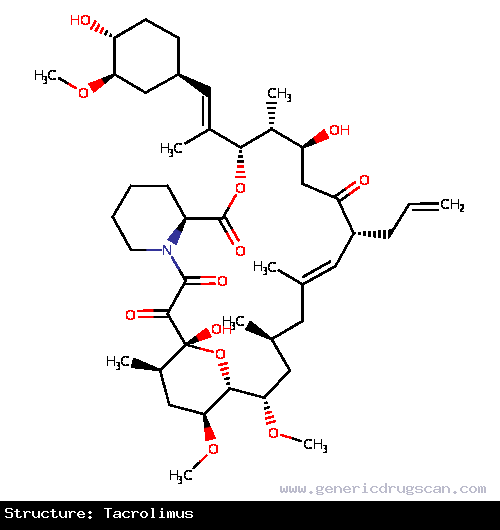Tacrolimus Drug: Indication, Dosage, Precaution, Side Effect , Storage, Category Type and corresponding Brands - www.genericdrugscan.com
Tacrolimus
Drug Status in USA : ApprovedDrug Status in Canada : Approved
pronunciation
pronounced as (ta kroe' li mus)
Why is this medication prescribed?
Tacrolimus is used along with other medications to prevent rejection (attack of a transplanted organ by the immune system of a person receiving the organ) in people who have received kidney, liver, or heart transplants. Tacrolimus is in a class of medications called immunosupressants. It works by decreasing the activity of the immune system to prevent it from attacking the transplanted organ.
How should this medicine be used?
Tacrolimus comes as a capsule to take by mouth. It is usually taken twice a day. Space your doses 12 hours apart, and take tacrolimus at the same times every day. Follow the directions on your prescription label carefully, and ask your doctor or pharmacist to explain any part you do not understand. Take tacrolimus exactly as directed. Do not take more or less of it or take it more often than prescribed by your doctor.
Your doctor will monitor you carefully and adjust your dose as needed. Talk to your doctor often about how you are feeling during your treatment. Ask your doctor if you have any questions about how much tacrolimus you should take.
Tacrolimus can only prevent rejection of your transplant as long as you are taking the medication. Continue to take tacrolimus even if you feel well. Do not stop taking tacrolimus without talking to your doctor.
What are the precautions to be followed?
Before taking tacrolimus,- tell your doctor and pharmacist if you are allergic to tacrolimus or any other medications.
- tell your doctor and pharmacist what prescription and nonprescription medications, vitamins, and nutritional supplements you are taking or plan to take. Be sure to mention any of the following: amphotericin B (Abelcet, Ambisome, Amphotec); antacids; certain antibiotics including aminoglycosides such as amikacin, gentamicin, neomycin (Neo-Fradin), streptomycin, and tobramycin (Tobi), and macrolides such as clarithromycin (Biaxin), erythromycin (EES, E-Mycin, Erythrocin), and troleandomycin (TAO) (not available in the US); antifungal medications such as clotrimazole (Lotrimin, Mycelex), fluconazole (Diflucan), itraconazole (Sporanox), ketoconazole (Nizoral) and voriconazole (Vfend); bromocriptine (Parlodel); calcium channel blockers such as diltiazem (Cardizem), nicardipine (Cardene), nifedipine (Adalat, Procardia), and verapamil (Calan, Covera, Isoptin); caspofungin (Cancidas); chloramphenicol; cimetidine (Tagamet); cisapride (Propulsid) (not available in the U.S.); cisplatin (Platinol); danazol (Danocrine); certain diuretics ('water pills'); ganciclovir (Cytovene); hormonal contraceptives (birth control pills, patches, rings, inserts, or injections); HIV protease inhibitors such as indinavir (Crixivan), nelfinavir (Viracept), and ritonavir (Norvir); lansoprazole (Prevacid); certain medications for seizures such as carbamazepine (Tegretol), phenobarbital, and phenytoin (Dilantin); methylprednisolone (Medrol); metoclopramide (Reglan); nefazodone; omeprazole (Prilosec); rifabutin (Mycobutin); rifampin (Rifadin, Rimactane); and sirolimus (Rapamune). Your doctor may need to change the doses of your medications or monitor you more carefully for side effects. Many other medications may also interact with tacrolimus, so be sure to tell your doctor about all the medications you are taking, even those that do not appear on this list.
- tell your doctor if you are taking or have recently stopped taking cyclosporine (Gengraf, Neoral, Sandimmune). If you were taking cyclosporine, your doctor will probably tell you not to start taking tacrolimus until 24 hours after you took your last dose of cyclosporine. If you stop taking tacrolimus, your doctor will also tell you to wait 24 hours before starting to take cyclosporine.
- tell your doctor and pharmacist what herbal products you are taking, especially St. John's wort.
- tell your doctor if you have or have ever had heart, kidney, or liver disease.
- tell your doctor if you are pregnant, plan to become pregnant, or are breast-feeding. If you become pregnant while taking tacrolimus, call your doctor.
- if you are having surgery, including dental surgery, tell the doctor or dentist that you are taking tacrolimus.
- you should know that taking tacrolimus may increase the risk that you will develop skin cancer. Protect yourself from skin cancer by avoiding unnecessary or prolonged exposure to sunlight or ultraviolet light (tanning beds) and wearing protective clothing, sunglasses, and sunscreen with a high skin protection factor (SPF).
- you should know that tacrolimus may cause high blood pressure. Your doctor will monitor your blood pressure carefully, and may prescribe medication to treat high blood pressure if it develops.
- you should know that there is a risk that you will develop diabetes during your treatment with tacrolimus. African American and Hispanic patients who have had kidney transplants have an especially high risk of developing diabetes during their treatment with tacrolimus. Tell your doctor if you or anyone in your family has or has ever had diabetes. If you experience any of the following symptoms, call your doctor immediately: excessive thirst; excessive hunger; frequent urination; blurred vision or confusion.
- do not have any vaccinations without talking to your doctor.
What are possible side effects of this medication ?
Tacrolimus may cause side effects. Tell your doctor if any of these symptoms are severe or do not go away:- headache
- uncontrollable shaking of a part of the body
- diarrhea
- constipation
- nausea
- vomiting
- heartburn
- stomach pain
- loss of appetite
- difficulty falling asleep or staying asleep
- dizziness
- weakness
- back or joint pain
- burning, numbness, pain, or tingling in the hands or feet
- rash
- itching
- decreased urination
- pain or burning on urination
- swelling of the arms, hands, feet, ankles, or lower legs
- weight gain
- unusual bleeding or bruising
- seizures
- coma (loss of consciousness for a period of time)
Tacrolimus may cause other side effects. Call your doctor if you have any unusual problems while you are taking this medication.
How to store the medication and dispose it of after its use later?
Keep this medication in the container it came in, tightly closed, and out of reach of children. Store it at room temperature and away from excess heat and moisture (not in the bathroom).
Unneeded medications should be disposed of in special ways to ensure that pets, children, and other people cannot consume them. However, you should not flush this medication down the toilet. Instead, the best way to dispose of your medication is through a medicine take-back program.
Drug Category/Class
- Calcineurin Inhibitors
- Agents for Dermatitis, Excluding Corticosteroids
- Dermatologicals
- Immunosuppressive Agents
- Antineoplastic and Immunomodulating Agents
- CYP3A4 Inhibitors
- Combined Inhibitors of CYP3A4 and P-glycoprotein
- Agents for dermatitis, excluding corticosteroids
- Calcineurin inhibitors
| Prescribed | For use after allogenic organ transplant to reduce the activity of the patient's immune system and so the risk of organ rejection. It was first app... |
| Weight : | 804.0182 |
| Structure | Tacrolimus |
 | |
| Formula | C44H69NO12 |
Tacrolimus has 64 Brands listed
Search Generic Drugs alphabetically
